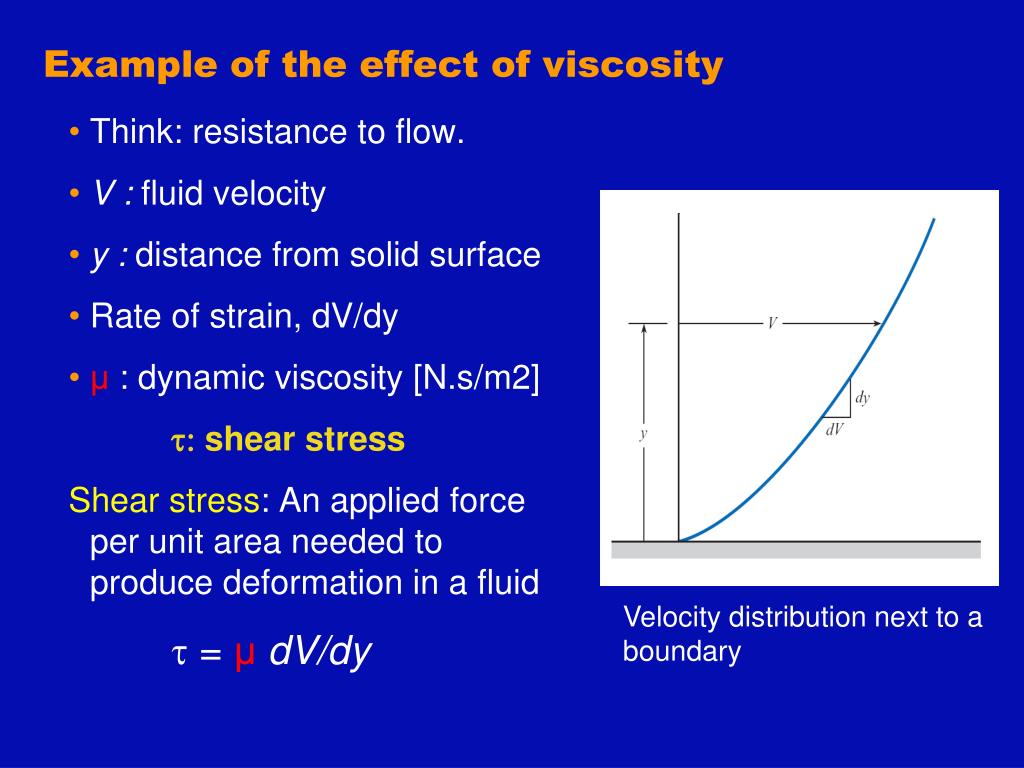


The rate of shear deformation is u / y and can be also written as a shear velocity, du/dy. The equation can be expressed in terms of shear stress τ = F/A = η(u/y). The absolute viscosity is also known as the dynamic viscosity, and is often shortened to simply viscosity. Combining these three relations results in the equation F = η(Au/y), where η is the proportionality factor called the absolute viscosity (with units Pa The applied force is proportional to the area and velocity of the plate and inversely proportional to the distance between the plates. If this force causes the substance between the plates to undergo shear flow (as opposed to just shearing elastically until the shear stress in the substance balances the applied force), the substance is called a fluid. Assuming that the plates are very large, with a large area A, such that edge effects may be ignored, and that the lower plate is fixed, let a force F be applied to the upper plate. The relationship between the shear stress and the velocity gradient can also be obtained by considering two plates closely spaced apart at a distance y, and separated by a homogeneous substance. Non-Newtonian fluids exhibit a more complicated relationship between shear stress and velocity gradient than simple linearity. Many fluids, such as water and most gases, satisfy Newton's criterion and are known as Newtonian fluids. Here, the constant η is known as the coefficient of viscosity, the viscosity, the dynamic viscosity, or the Newtonian viscosity. Isaac Newton postulated that, for straight, parallel and uniform flow, the shear stress, τ, between layers is proportional to the velocity gradient, ∂ u/∂ y, in the direction perpendicular to the layers. In general, in any flow, layers move at different velocities and the fluid's viscosity arises from the shear stress between the layers that ultimately opposes any applied force. Volume viscosity is essential for Acoustics in fluids, see Stokes' law (sound attenuation) Newton's theory Extensional viscosity is widely used for characterizing polymers. For example, at "room temperature", water has a nominal viscosity of 1.0 × 10 -3 Pa∙s and motor oil has a nominal apparent viscosity of 250 × 10 -3 Pa∙s. Simply put, this quantity is the ratio between the pressure exerted on the surface of a fluid, in the lateral or horizontal direction, to the change in velocity of the fluid as you move down in the fluid (this is what is referred to as a velocity gradient). That is why they are often referred to as simply viscosity. Shear viscosity and dynamic viscosity are much better known than the others. Extensional viscosity is the viscosity coefficient when applied stress is extensional stress valid for non-Newtonian fluids.Shear viscosity is the viscosity coefficient when applied stress is a shear stress, valid for non-Newtonian fluids.Bulk viscosity is the same as volume viscosity.Volume viscosity is the viscosity coefficient that determines the dynamics of compressible Newtonian fluid.Kinematic viscosity is the dynamic viscosity divided by the density for Newtonian fluid.Dynamic viscosity is the viscosity coefficient that determines the dynamics of incompressible Newtonian fluid.


They are introduced in the main books on hydrodynamics and rheology. There are several different viscosity coefficients depending on the nature of applied stress and nature of the fluid. When looking at a value for viscosity, the number that one most often sees is the coefficient of viscosity. A viscous glue was made from mistletoe berries and used for lime-twigs to catch birds. The word "viscosity" derives from the Latin word " viscum" for mistletoe. 5.1.1 Effect of temperature on the viscosity of a gas.4.1.3 Dynamic versus kinematic viscosity.4.1.1 Viscosity (dynamic/absolute viscosity).


 0 kommentar(er)
0 kommentar(er)
